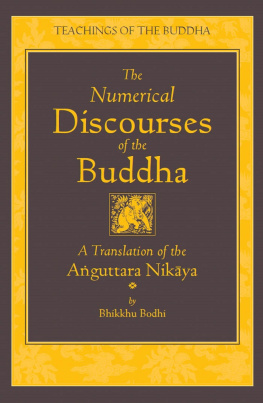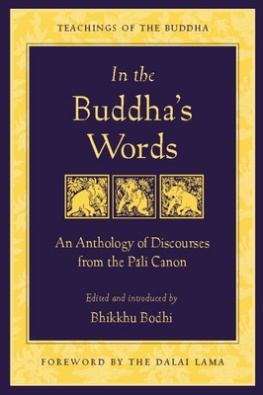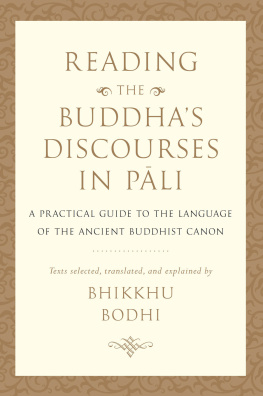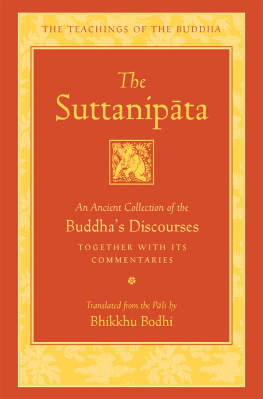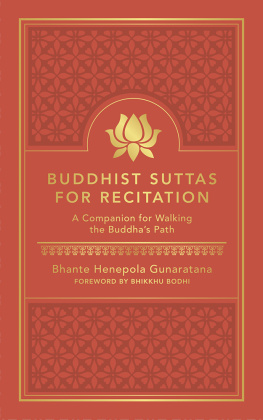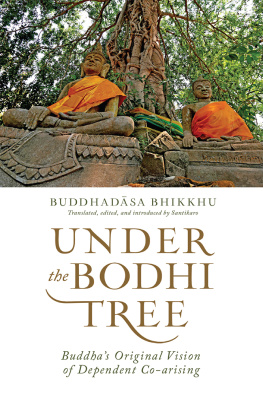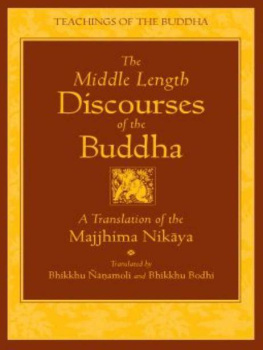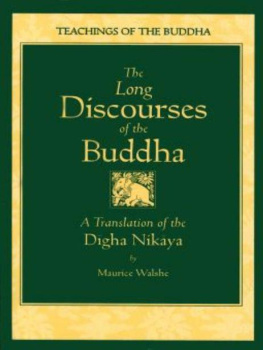THE TEACHINGS OF THE BUDDHA SERIES
The Long Discourses of the Buddha:
A Translation of the Dgha Nikya
The Middle-Length Discourses of the Buddha:
A Translation of the Majjhima Nikya
The Connected Discourses of the Buddha:
A Translation of the Sayutta Nikya
In the Buddhas Words:
An Anthology of Discourses from the Pli Canon
Great Disciples of the Buddha:
Their Lives, Their Works, Their Legacy
PUBLISHERS ACKNOWLEDGMENT
For their help in supporting the printing of this book, the publisher gratefully acknowledges the generous help of the Hershey Family Foundation and the kind contribution made in loving memory of Gan Chin Hong and Young Cheng Chu by their family.

Wisdom Publications
199 Elm Street
Somerville MA 02144 USA
wisdompubs.org
2012 Bhikkhu Bodhi
All rights reserved.
No part of this book may be reproduced in any form or by any means, electronic or mechanical, including photography, recording, or by any information storage and retrieval system or technologies now known or later developed, without permission in writing from the publisher.
Library of Congress Cataloging-in-Publication Data
Tipiaka. Suttapiaka. Aguttaranikya. English.
The numerical discourses of the Buddha : a translation of the Aguttara Nikya / translated from the Pli by Bhikkhu Bodhi.
pages cm (The teachings of the Buddha)
The present work offers a complete translation of the Aguttara Nikya, the fourth major collection in the Sutta Piaka, or Basket of Discourses, belonging to the Pli Canon.
Includes bibliographical references and indexes.
ISBN 1-61429-040-7 (hardback : alk. paper)
I. Bodhi, Bhikkhu, translator. II. Title.
BQ1342.E5B63 2012
294.3823dc23
2012007302
ISBN 978-1-61429-040-7 eBook ISBN 978-1-61429-044-5
19 18 17 16 15
6 5 4 3 2
Cover and interior design by Gopa&Ted2. Set in Palladio 10/12.4.
Contents
The present work offers a complete translation of the Aguttara Nikya, the fourth major collection in the Sutta Piaka, or Basket of Discourses, belonging to the Pli Canon. An English translation of the Aguttara Nikya published by the Pali Text Society has long been in print under the title The Book of the Gradual Sayings. It was issued in five volumes, I, II, and V translated by F. L. Woodward, and III and IV by E. M. Hare. First published between 1932 and 1936, this translation is now dated both in style and technical terminology, and thus a fresh English rendering of the entire work has long been a pressing need. In the late 1990s I collected Nyanaponika Theras four-part series of Wheel booklets, An Aguttara Nikya Anthology, into a single volume for the International Sacred Literature Trust. I added sixty suttas to the original anthology, and the resulting volume was published as Numerical Discourses of the Buddha: An Anthology of Suttas from the Aguttara Nikya (Walnut Creek, CA: AltaMira Press 1999). This compilation, with a total of 208 suttas, contained perhaps an eighth of the full Aguttara Nikya. Translations of many individual Aguttara suttas have also been available over the internet, but a selection, however valuable, cannot do service for a translation of the complete work.
This translation, like my previous renderings from the Pli Canon and commentaries, aims to fulfill two ideals that are to some degree in tension with one another: first, to be faithful to the meaning of the original; and second, to express this meaning in clear contemporary English. My translation is based on three different editions of the Pli text. I used the Sinhala-script Buddha Jayanti edition as my root text, and I am grateful to Ven. Dhammajva Thera of Mitirigala Nissaraa Vanaya for presenting me with a full set of these volumes. I compared this edition with the Vipassana Research Institutes electronic version of the Burmese-script Chaha Sagyana (Sixth Council) edition and with the PTSs Roman-script edition. I also consulted the variants noted in the PTS edition, which occasionally, in my view, had a better reading than the printed editions. In defense of this eclectic approach I appeal to Professor E. Hardys words in his preface to part V of his PTS edition of the Aguttara Nikya: It may be open to dispute, whether our Sinhalese Mss. [manuscripts] of the Aguttara are the more reliable, or our Burmese. As a rule, there is no Ms. nor any set of Mss. which can be relied on indiscriminately (p. v).
The contents of the Aguttara Nikya (AN) prove especially challenging to modern readers because there is virtually no rhyme or reason to their order apart from their conformity to the numerical scheme that governs each book. To help the reader make sense of the work, I prepared a thematic study guide to AN, which follows the introduction (see pp. 7584). The guide lays out the principal themes of this collection in a meaningful sequence, which is similar to the one I used in my anthology In the Buddhas Words. On this basis I then classified the suttas (the great majority, though not all) according to the way they exemplify the scheme. I suggest that readers new to AN consider reading the work twice. First, read the suttas in the order in which they fit into the thematic guide; then read the entire Nikya again in the original order, from the Ones through the Elevens. The first reading will enable readers to grasp the main contours of the Buddhas teachings as they are represented by AN; the second will enable them to follow the work in its original arrangement. My long introduction is primarily intended to explain AN using the thematic guide as a framework for making sense of the mountain of material found in this collection.
In the course of preparing this translation, I have had the generous help of several people whose contributions have been invaluable. First and foremost is John Kelly, who offered his help even before I actually embarked on the project and unfailingly assisted me through the six years it has taken to bring the work to completion. A keen student of Pli since 2003, John read the translation alongside the Pli text at several stages, offering useful comments and suggestions and occasionally catching lines of text that I had overlooked. He maintained the electronic files, entered the page numbers of the PTS edition into the files, compiled the two appendixes and index of proper names, and checked page proofs. His article, The Buddhas Teachings to Lay People, which I cite several times in the introduction, is a bountiful source of information that helps us better understand the place of the Aguttara Nikya in the corpus of Buddhist canonical literature. Occasionally Johns wife Lynn also offered suggestions.
Another major helper was Bhikkhu Brahmli of Bodhinyana Monastery in Serpentine, Australia. Ven. Brahmli read the translation alongside the Pli text in two stages, offering incisive comments. Often his comments necessitated revisions in the draft or required me to add explanatory notes to clarify the reasons behind my rendering. On a few occasions I have quoted Ven. Brahmlis comments in my notes.
Ven. Vanarata nanda Thera, a senior bhikkhu in Sri Lanka, checked my translations of the verse portions of AN. He wrote extremely helpful comments into a printout of the manuscript, which Bhikkhu Nyanatusita kindly photographed and sent to me by email. I have occasionally included Ven. Vanaratas remarks in the notes.
Bhikkhu Psdiko, William Pruitt, and Bhikkhu Khemaratana read various versions of the translation and offered useful suggestions and comments. Pamela Kirby reviewed the proofs with sharp eyes for minor typographical and stylistic flaws. My student Pohui Chang helped review the indexes and checked my Chinese renderings in the notes.
Next page
